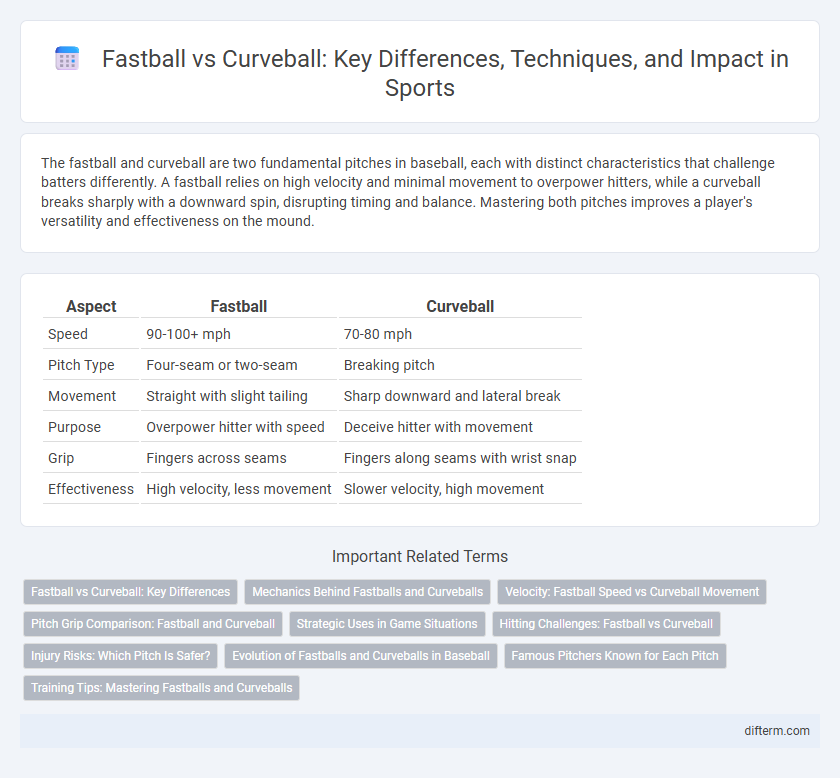The fastball and curveball are two fundamental pitches in baseball, each with distinct characteristics that challenge batters differently. A fastball relies on high velocity and minimal movement to overpower hitters, while a curveball breaks sharply with a downward spin, disrupting timing and balance. Mastering both pitches improves a player's versatility and effectiveness on the mound.
Table of Comparison
| Aspect | Fastball | Curveball |
|---|---|---|
| Speed | 90-100+ mph | 70-80 mph |
| Pitch Type | Four-seam or two-seam | Breaking pitch |
| Movement | Straight with slight tailing | Sharp downward and lateral break |
| Purpose | Overpower hitter with speed | Deceive hitter with movement |
| Grip | Fingers across seams | Fingers along seams with wrist snap |
| Effectiveness | High velocity, less movement | Slower velocity, high movement |
Fastball vs Curveball: Key Differences
The fastball and curveball differ primarily in speed and trajectory, with the fastball typically reaching velocities between 90-100 mph and following a straight path, while the curveball slows down to around 70-80 mph and features a pronounced downward and lateral break due to topspin. The grip and arm angle variations contribute to the distinct movement patterns, making the fastball ideal for overpowering hitters and the curveball effective for deception and inducing swings and misses. Understanding these key differences helps pitchers strategically select pitches to maximize effectiveness during gameplay.
Mechanics Behind Fastballs and Curveballs
Fastballs rely on high velocity generated through explosive arm and wrist action, maximizing backspin to create a straight, fast trajectory. Curveballs use a snapping wrist motion and downward finger pressure to impart topspin, causing the ball to dive sharply as it approaches the plate. The distinct grip and release angles between fastballs and curveballs are critical for their contrasting movement patterns in baseball pitching mechanics.
Velocity: Fastball Speed vs Curveball Movement
Fastballs typically reach velocities between 90-100 mph, making them one of the fastest pitches in baseball and challenging hitters with their straight, high-speed trajectory. In contrast, curveballs generally range from 70-80 mph, relying on sharp downward and lateral movement rather than speed to deceive batters. The significant speed difference combined with the curveball's pronounced break creates a critical timing challenge for hitters adjusting to these contrasting pitch dynamics.
Pitch Grip Comparison: Fastball and Curveball
The fastball pitch grip typically involves holding the baseball with two fingers across the seams, providing maximum velocity and backspin for a straight trajectory. In contrast, the curveball grip places the middle finger along the seam and the thumb underneath, applying pressure to create topspin that results in a sharp downward break. These distinct grips optimize spin rate and ball movement, essential for executing effective pitches in baseball.
Strategic Uses in Game Situations
Fastballs are strategically employed to challenge hitters with high velocity, often used early in counts to establish pitcher dominance and set up subsequent pitches. Curveballs serve as effective off-speed pitches designed to disrupt batter timing, especially useful in two-strike counts to induce swings and misses or weak contact. The combination of fastballs and curveballs creates a tactical balance that exploits hitter weaknesses and maximizes strikeout potential in critical game situations.
Hitting Challenges: Fastball vs Curveball
Hitting a fastball demands quick reaction times due to its high velocity, often exceeding 90 mph, leaving little room for error. Conversely, a curveball challenges the hitter's timing and pitch recognition by incorporating a significant downward spin that causes the ball to drop sharply as it approaches the plate. Mastering these distinct hitting challenges requires batters to develop advanced hand-eye coordination and adaptability to effectively anticipate and respond to varying pitch speeds and trajectories.
Injury Risks: Which Pitch Is Safer?
Fastballs generally pose a higher injury risk to pitchers due to the intense stress placed on the shoulder and elbow joints from maximum velocity efforts. Curveballs, while requiring a different arm motion that can strain the elbow ligaments, tend to be safer when thrown with proper mechanics and conditioning. Studies indicate that improper execution of either pitch increases injury likelihood, but controlled curveball use may reduce overall arm stress compared to repetitive high-velocity fastball pitching.
Evolution of Fastballs and Curveballs in Baseball
Fastballs have evolved from simple four-seam grips to a variety of styles including two-seam, cutter, and sinker, enhancing velocity and movement to challenge hitters. Curveballs have transitioned with advancements in grip techniques and spin rate, increasing their sharp downward break and deception. Modern analytics emphasize spin efficiency and release points, driving pitchers to refine both pitches for strategic advantage in baseball competitions.
Famous Pitchers Known for Each Pitch
Nolan Ryan is legendary for his devastating fastball, reaching speeds above 100 mph that consistently overwhelmed hitters and set strikeout records. Meanwhile, Sandy Koufax is celebrated for his masterful curveball, which baffled batters with its sharp break and precise control, contributing to his Hall of Fame career. These iconic pitchers exemplify the dominance achievable through mastery of distinct pitches in Major League Baseball.
Training Tips: Mastering Fastballs and Curveballs
Mastering fastballs and curveballs requires targeted training techniques emphasizing grip, wrist snap, and release point for precise pitch control. Consistent repetition in bullpen sessions builds muscle memory, while video analysis helps refine mechanics to increase velocity and spin rate. Incorporating strength training, particularly wrist and forearm exercises, enhances pitch speed and movement, improving overall effectiveness on the mound.
fastball vs curveball Infographic

 difterm.com
difterm.com